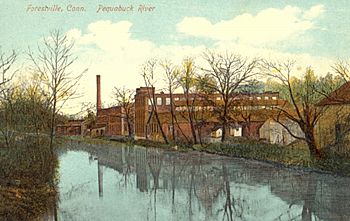Pequabuck River facts for kids
Quick facts for kids Pequabuck River |
|
|---|---|

Early 20th-century postcard portraying the Pequabuck River in Forestville, Connecticut
|
|
| Country | United States |
| State | Connecticut |
| Counties | Litchfield County, Hartford County |
| Physical characteristics | |
| Main source | Harwinton, Litchfield County, Connecticut, United States |
| River mouth | Confluence with Farmington River Farmington, Hartford County, Connecticut, United States |
| Length | 19 mi (31 km) |
| Basin features | |
| Basin size | 58.4 sq mi (151 km2) |
| Tributaries |
|
The Pequabuck River is a river in Connecticut, United States. It is about 19 miles (30.6 km) long. The river starts in Litchfield County. It then flows through Hartford County. Finally, it joins the Farmington River in Farmington.
This river was very important for the growth of towns like Plainville, Connecticut. It helped power many early factories.
Contents
What's in a Name?
The name Pequabuck comes from an old Algonquin phrase. This language was spoken by Native American tribes. The phrase means "clear pond" or "open pond."
People believe this name first described a pond or wet area. This pond was located where the Pequabuck River begins.
River's Role in History
The Pequabuck River played a big part in the history of local industries. Its flowing water was a source of power.
Powering Early Factories
The river's water helped turn a water wheel. This wheel provided power for factories. One example was the Upper Lock Shop in Plymouth, Connecticut. This shop later became the Lewis Lock Company in 1851. It eventually grew into the famous Eagle Lock Company.
Iron Works Along the River
The river banks were also home to one of the first places in the United States to make a special kind of iron. This place was called Malleable Iron Works. It later became known as Andrew Terry and Company.
River Health
Today, the lower parts of the river flow through areas with industries and towns. Because of this, the river's water can be affected by things from these areas. People and groups are working to keep the river clean and healthy for everyone.

